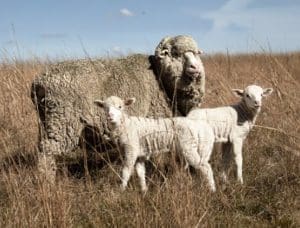
Dr Kim Bunter of the University of New England.
EWE pregnancy scanning research has found the lambing date of most ewes can be accurately predicted, enabling targeted management of pregnant ewes.
A joint CSIRO and University of New England study found that estimating foetal age by measuring the head size – the bi-parietal diameter of the foetus head — accurately predicted the foetal age of the lamb.
This allowed for prediction of the lambing date of the ewe and meant management could be tailored to pregnancy stage and litter size.
Australian Wool Innovation said the study found that using a single scanning event with an experienced operator who understood the change in BPD size with foetal age, about 80 percent of ewes could be correctly allocated to three lambing groups.
Moreover, no ewe assigned to an early lambing group, via predictions based on foetal aging, lambed in the tail end of the lambing time, or vice-versa. This confirmed that an appropriate method of scanning to discriminate between early and late lambing ewes is 100pc accurate, AWI said.
Foetal age scanning can inform pregnant ewe management

A Merino ewe with twin lambs. Picture – AWI.
AWI said combined with scanning for fertility and litter size, additional scanning for foetal age proved to be a cost-effective and efficient practice that can inform the management of pregnant ewes.
The research to investigate the efficacy of scanning for foetal age to predict lambing dates was led by Dr Kim Bunter at the Animal Genetics and Breeding Unit at UNE, with co-researchers Doug Fowler from Australian Livestock Scanning Services Group and Dr Jen Smith from CSIRO. The researchers tested different methods of predicting lambing dates to confirm the most efficient method to assign lambing dates for pregnant ewes.
“If your scanner operator can estimate the foetal age at the time of scanning, by default you can work out what day the ewe became pregnant and you can project the lambing date of that ewe.
“This allows you to feed and manage accordingly, which could help to reduce ewe and lamb mortality and optimize weaning processes,” Dr Kim Bunter said.
“In our genetic evaluation systems we have plenty of early in life traits which require age corrections, so if we have lambs born with no date of birth known and we can’t correct for those things, we have producers or breeders choosing animals who were simply born earlier – and which are not necessarily genetically better – for things like weight in young animals.”
Dr Bunter said the BPD measurements taken in the study were done on foetuses estimated to be 35-100 days old. She said the research highlighted the need for training of pregnancy scanning contractors and/or development of technology to increase the efficiency and accuracy of BPD measurements.
Click here to listen to The Yarn podcast interview with Dr Kim Bunter.
Source: AWI.

HAVE YOUR SAY